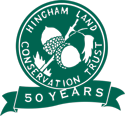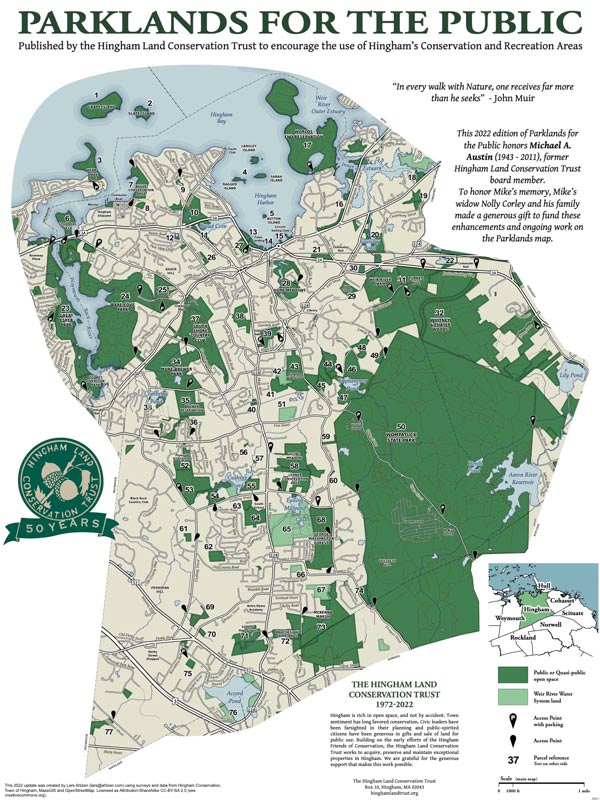The park is located in northwest Hingham, is located in an area bounded by the Back River on the west, Lincoln Street (Route 3A) on the north, Beal Street on the northeast, Fort Hill Street on the southeast and Fresh River on the south.
The Weymouth Back River rises from several ponds and swamps, including Whitman Pond in Weymouth. It flows for about 10 miles, and empties into the Atlantic Ocean at Hingham Bay, downstream of the park, and just south of Grape Island and Slate Island. The tidal Back River forms inlets and coves along the eastern boundary Bare Cove Park. The uplands in the park are made up of hills, glacial ridges, eskers, meadows and woodlands. Beyond the park the land rises to Squirrel Hill and Baker Hill in the east and Fort Hill in the southeast and across the river in the west by the Great Esker of Great Esker Park.
When the settlers first came in the 1630s the route to Boston they first established went from Town Street (North and South Streets ) via Fort Hill Street, (near the future southeast boundary of Bare Cove Park) through Weymouth, Quincy and Milton to Boston. In 1808 the Hingham, Quincy Bridge Turnpike Company was chartered. In the 1810s the company constructed a turnpike following Beal Street in Hingham to a bridge crossing of Back River, along Bridge Street in Weymouth to a bridge crossing of Fore River continuing the turnpike on Washington Street in Quincy. The turnpike enclosed the east and north boundaries of Bare Cove Park. The Charter ended in 1864 and with it, tolls were discontinued.
In the area near the park entrance off of Beal Street behind Lynch Field was an Alms House. The Alms House, or Town Farm, was charitable housing designed to help the indigent, particularly widows, the elderly and those unable to pay their rent. In the 1800’s there were several Alms Houses in Hingham. The Almshouse at this location was built in 1832 and lasted for over 100 years.
The land where the park now stands was privately owned until the early 1900s. The rolling hills, meadows, swamps, and woodlands of the area were home mainly to herring fishermen, duck hunters, and farmers. At the time many of the land owners were from long-established Hingham families, with names that read like a street directory: Hersey, Baker, Bates, French, and Beal, to cite a few.
Hingham originally came to the military’s attention shortly after the Spanish-American War, when the Navy sought a more isolated place than Chelsea for its main East Coast ammunition depot. Starting in 1906, the Navy began buying property (some through eminent domain) in the crescent-shaped area bordered by Route 3A; Beal, West, and Fort Hill streets; and the Back and Fresh Rivers. A slice of land on the Weymouth side of the river (Great Esker Park) was acquired as a buffer zone. Records show that the land went for about $100 an acre.
Construction on the base began in 1911 and the Navy established the Hingham Naval Ammunition Depot, also known as Hockley Hollow on the site. In 1917, Camp Hingham Naval Station, a training camp, was established nearby as well. Camp Hingham — which included 17 barracks and a hospital — was demolished in 1925, but the ammunition depot remained.
At its peak in 1945, the base included more than 100 buildings: barracks, houses, a PX, arms workshops, 15 cranes and scores of storage facilities — both above and below ground — packed with munitions. During the war, the Navy built an annex to the depot on land in Hingham, Cohasset, Norwell, and Scituate; much of that site is now Wompatuck State Park. Rail spurs were built from the Greenbush Line at Cohasset Station to Wompatuck and across Fort Hill Street at Bare Cove to serve the annex and the depot.
At its peak, the Hingham Naval Ammunition Depot employed over 2,400 people, both civilians and military personnel. In their down time those, living at the depot had an on site Howard Johnson’s restaurant for dining. The Depot also had a jazz band which had acclaimed saxophonist John Coltrane, who was stationed there, as a member.
During World War II, the base was beefed up to become the principal arsenal of the Atlantic fleet, as well as a storehouse for naval forces in the Pacific. But ammunition wasn’t its only business. The base was expanded to include the Naval Materials Handling Laboratory. While that may not sound as glamorous as assembling top-secret fuses, the Navy could not have sustained operations halfway around the world without advances in shipping techniques and equipment.
The team at the materials lab devised more efficient ways to pack, load, and transport everything from munitions to meat sauce, boots to binoculars. Among those playing a key role at the lab was a lieutenant from Maine and one-time Harvard track star, Norman L. Cahners. He demonstrated that cargo packed on pallets could be loaded and unloaded in half the time with a quarter the manpower. He patented a four-way pallet that allowed forklifts to approach from any direction and maneuver in tight spaces.
The base at Bare Cove was decommissioned in 1961. After the base was closed, the Army Corps of Engineers swept the area for hazardous materials, and the Navy turned the 905-acre site over to the Town of Hingham in 1972. Attracted by the opportunity to recycle the steel, copper, and other materials left behind, a salvager paid Hingham for the right to clear the area. 32 acres of land on the northern shore, owned by the Department of Fisheries and Wildlife Bare Cove Park, were combined with 484 acres of the Naval Ammunition Depot to create Bare Cove Park, which opened as a wildlife sanctuary and recreation area in 1974.
While Bare Cove Park hugs the shore line, residential property buffers it from much of Beal and Fort Hill Streets. Exceptions are Lynch Field at the Beal Street entrance; the South Shore Conservatory on the west side of the park on the site of a former commander of the Naval Ammunition Depot; and the property abutting the Fort Hill Street entrance. The Fort Hill Street entrance area has an auto body shop, a school bus depot, a DPW building, a recreation field, a Fire Museum and a Railroad Club in repurposed military buildings. In addition, a Dock House inside the park overlooking Back River houses a museum founded and curated by the park’s ranger, Scott McMillan, whose father and maternal grandfather worked at the depot.
On display in glass cases are assorted artillery shells, dusty soda bottles, weathered telephones, gas masks, spark-proof tools, medical stitching, flare guns, and countless other relics that McMillan and others have scavenged since the base was decommissioned in 1962. The museum walls are covered with historic photos, including one of the base’s jazz band; among the faces you’ll see is a young John Coltrane, who was briefly stationed in Hingham during World War II. The museum is scheduled annually for the public visits at mid-day, two Sundays a month from March to November.
Since the property was actively used for much of the 20th century, with the exception of the marsh and river, vegetation here is relatively young. Some pine, oak, beech, birch, sumac and cedar are present along the edges of the roads and paths. Mammals commonly found at Bare Cove include long-tailed weasel, mink, striped skunk, red and gray fox, white tailed deer, eastern cottontail rabbit, meadow vole, coyote, opossum, raccoon and field mouse. Birds include American Kestrel, Double-crested Cormorant, Killdeer, Snowy Egret, Ruby Throated Hummingbird, Wood Duck, Red Shouldered Hawk, Great Horned Owl, Screech Owl, Barred Owl, Osprey, Great Blue Heron, Mallard. Fish include smelt, blue-back Herring and Striped Bass.
Today, all that remains of the Hingham Depot are its paved and unpaved roads; remains of old wharves and railroad ties; scattered fire hydrants; and a few buildings. There are also swaths of open grassland that had once been magazines, and grass-covered hillocks, reminiscent of Indian burial mounds, concealing underground storage bunkers.
Together with Great Esker Park land, this parkland forms one of the foremost scenic, urban-centered open spaces in New England and protected, precious tidewaters and salt marshes. Bare Cove Park’s 5+ miles of paved roadways and woodland trails are ideal for walking, jogging, and bicycling. There are also several picnic sites. This is a great place to ride bikes with young children. Motorized vehicles are prohibited.
Parking is available at the two park entrances, one on Beal Street next to the Lynch Fields and across from Terry Drive, and the other off Fort Hill Street across from the Hingham Commuter Rail Station. On the half mile drive from Fort Hill Street to the trail entrance the road goes by a Town owned Carlson Fields Athletic Complex including ball fields, basketball courts and a skateboard park, with a parking area. It also passes a Department of Public Works facility and Bare Cove Fire Museum on the right and the South Shore Model Railway Club on the left at the parking lot.
Off-leash dog walking, which is allowed only on odd calendar days, requires a permit that can be obtained at the Hingham Town Hall. Dogs may be walked on even calendar days but must be leashed at all times.
Of many options for walking, two start at the Beal Street entrance: Conservatory Loop and River & Ridge Walk. From the Fort Hill entrance are a North Loop and an Indian Point and woods walk.
From the Beal Street entrance next to Lynch Field, follow Sheltry Path to an open triangular field and turn right onto the road on the near side of the field. Just before the merge with Bare Cove Path at the end of the triangle, turn left onto a dirt trail leading up a rise toward the river. A high point on the trail offers views across the river as does much of the riverside walk.
The trail turns left and rejoins the paved road near a historic information kiosk. Turn right onto Bare Cove Path and follow it past the dock house. As the road veers left, stay to the right onto the unpaved riverside trail and continue along the waterfront. Stay on the waterfront trail along the Back River and near-side of the Beal Cove Inlet. Watch for a few places where the trail is steep and narrow and for loose stones in the pathway. Enjoy the views as you go, until the trail returns to Back River Path.
Turn right onto the paved road and in a short distance you will come to an exercise station. Turn left at the station and follow the trail up the slope keeping to the left as you near the top. Continue along the ridge line trail with the river on your left. Stop to enjoy the river views and geological formations as you go. Keep right when the ridge splits in two directions and continue to follow the trail down to a field beyond the dock house and back to the paved Bare Cove Path. Turn right on Bare Cove Path, then bear right again onto Sheltry Path and back to the Beal Street entry.

Recommended Trail Activities: Walking, Hiking, Trail Biking Length: 1.3 Route Type: Trail (Narrow), Path (Medium), Road (Wide) Difficulty (Grade/Surface): Moderate Parking: Adequate Dog Restrictions: Off-leash Walking with Permit Ancillary Activities: Birding, Picnic, Natural Features, Historic Sites

